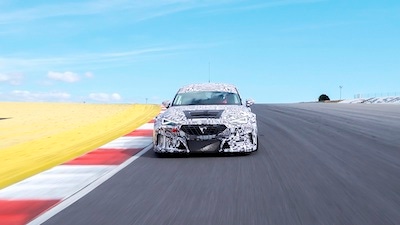The new Cupra Leon Competición’ steering wheel center control module, bonnet air vents, door mirrors and brake and water cooling inlets are fabricated using 3D printing technology from HP.
February 25, 2020

At first glance it looks like a normal mirror, but it isn't. It is a 3D-printed part, a technology that Cupra, the performance spin-off brand of Spain’s SEAT, has begun to implement in the development of the new Leon Competición in collaboration with HP. Greater agility, efficiency and flexibility are the benefits of a system that is set to revolutionize car development according to Cupra.
|
The door mirror, as well as air intakes and cooling intakes, have been fabricated using 3D printing. Image courtesy of SEAT. |
|
“For the new Cupra Leon Competición we modelled the steering wheel center control module, bonnet air vents, door mirrors and brake and water cooling inlets,” says Xavi Serra, the Head of technical development at Cupra Racing. These parts were produced using HP’s industrial grade Jet Fusion 5200 3D printing solution and included in the demanding development tests put to the new racing model.
This 3D printing technology features multiple benefits. “The main goal is to have a lot of parts in a short time. We can quickly test a wide variety of designs and furthermore, since vehicle development is now done in parallel, this technology enables us to react swiftly to any changes in the design process”, Xavi points out.
“The work with Cupra demonstrates the power of 3D printing and digital manufacturing – changing the way the world designs and manufactures”, explains Virginia Palacios, head of Systems Product Management, 3D Printing & Digital Manufacturing, HP Inc.
In touring car racing, the door mirror is a part which, according to the rules, must have the same shape as the production car. But the Cupra engineers went one step further. “We wanted to add an additional function, which is to cool the driver. We therefore had to design an air intake in the maximum pressure zone to achieve this effect”, Xavi indicates. The place where these materials are tested is the wind tunnel, where the 3D printed parts are verified in exactly the same way as the rest. “The bigger the variety of parts we can test in this facility, the better. It enables us to make much faster progress”, says Xavi.
As it is a racing car, the final phase of development can only be carried out in one place: the motor racing circuit. More specifically, the Leon Competición with its 3D printed parts was put to the limit on the Portimao track in Portugal. “The results were excellent, and some were even surprising, because we were looking to push the material to its limits”, says the Cupra engineer.
“3D printing is going to signal a turning point in the automotive industry by accelerating lead times and HP 3D technology is helping designers create parts that could not be produced with other technologies”, says Palacios. “This technology is and will continue to be key in countless fields to make the most complex ideas a reality”, concludes Xavi.
Paul Benning, Chief Technologist for HP 3D Printing & Digital Manufacturing agrees about the future potential of additive manufacturing in the auto sector. Speaking to PlasticsToday, he commented: “Historically, the automotive sector has relied on 3D printing technologies for prototyping. As metal and plastic 3D printing platforms that facilitate mass production are integrated into the auto environment, there has been a move toward the use of 3D printing for full-scale final part production – as seen with Volkswagen’s announcement to incorporate HP’s Metal Jet technology into its product roadmap for the production of new electric vehicles.”
Adds Benning: “One opportunity related to automated assembly is the invention of new methods and evolution of materials science, including the eventual ability to combine metals and plastics together into the same production cycle. While there’s currently not a printer that can combine both materials due to factors such as processing temperature, it will surely be a game changer for the auto industry once this capability arrives – particularly as a cost and time saver.”
This is part of HP’s larger vision for not just automotive applications, but for all industries leveraging 3D printing technologies. “We have more progress to make in the advancement of automated assembly, but we envision a future where it will come to fruition on the factory floor within the next 5 years,” concludes Benning.
A-3D-printed-racecar_08_HQ/ A-3D-printed-racecar_09_HQ
The Leon Competición was put to the limit on the Portimao track in Portugal. Image courtesy of SEAT.
About the Author(s)
You May Also Like





